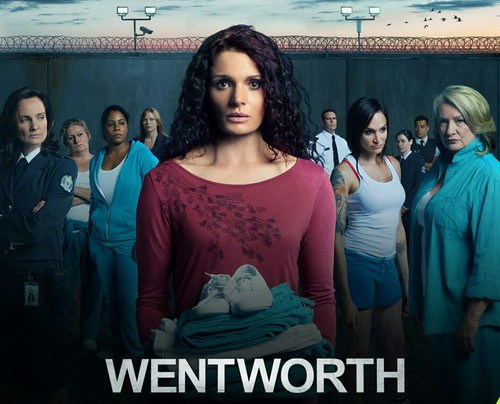 |
| Wentworth poster |
Written by Amanda Rodriguez
Wentworth is an Australian women’s prison drama that is much grittier, darker, more brutal and realistic than Netflix’s Orange is the New Black could ever hope to be. This bleak realism also makes Wentworth‘s well-developed characters and situations much more compelling than its fluffier American counterpart. Don’t get me wrong; I really enjoyed Orange is the New Black. The stories of incarcerated women are always important because they are a particularly marginalized and silenced group. However, the over-the-top, zany approach to characterization that OITNB utilizes for comedic effect renders the characters less substantive overall. Consider the lesbian-obsessed prison worker Caputo who has a mail order Russian bride or the insane abortion doctor murderer and ex-meth addict Pennsatucky Doggett who believes she has a calling from Jesus or the flame-haired Russian mobster cook Red played by my beloved Captain Kathryn Janeway (er, I mean Kate Mulgrew). Very colorful. Very little depth.
 |
| Pennsatucky is one craaaaaaaazy lady. |
Though OITNB and Wentworth deal with similar themes, Wentworth (based on an Aussie soap opera from the 70’s and 80’s called Prisoner) takes a no-holds-barred approach to subjects like officer sexual exploitation of prisoners, turf wars and hierarchy, sexuality, the inmate code of silence, gang beatings, gang rapes, prison riots, and the brutality of the crimes that landed these women behind bars. Because the Australian prison system is different from ours, my first glimpse of Wentworth Correctional Centre left me comparing the prison to middle school with its catty girls and basic rights stripped from the inmates, much like the ones that are stripped from children, i.e. rules govern when they use the restroom, showers, bed times, how they spend their free time, classes are mandatory, and they are allowed no privacy save that which they sneak. The finale of the first episode (“No Place Like Home”) concludes, however, in a chaotic riot with a body count, leaving a major character dead. I rapidly revised my initial reading, realizing that the women of Wentworth play for keeps in a way that those of OITNB do not.
The show evokes a primal sense of self-preservation amidst the complete absence of the basic human need for safety. It is unflinchingly honest in its representations of women who’ve committed terrible acts, lived complicated lives, and must continue their struggle for survival in the place that’s supposed to give them structure and rehabilitate them but in actuality further hardens and traumatizes them.
The racial diversity of Wentworth‘s cast leaves a bit to be desired. One of the primary prison guards, Will Jackson, is played by Robbie Magasiva, a Samoan New Zealander.
 |
| Mr. Jackson escorts our heroine, Bea Smith. |
Aboriginal Shareena Clanton portrays the integral matriarchal role of prisoner Doreen Anderson.
 |
| Doreen Threatens to cut Bea in order to keep the child she protects on their unit (that’s right, Aussies have kids in prison). |
Lastly, there’s Frankie Doyle’s steady girlfriend, Kim Chang, played by Korean Ra Chapman.
 |
| Kim walks with her lover Frankie. |
To be fair, I don’t know enough about the racial/ethnic composition of Australia to know what would constitute a balanced representation. In addition, though, there isn’t as much lesbianism as one might expect from the show either, though the lesbianism depicted is as graphic as the rest of the series. Though there are more lesbian characters in OITNB, I often wondered why their relationships were so censored on Netflix that can call its own shots…was it an effort to not exploit lesbian sexuality as so many shows typically do or was it to not “turn off” viewers?
On Wentworth, Frankie Doyle is the only major LGBTQ character along with her minor character girlfriend, Kim. We also find that the “Governor” Erica Davidson harbors a secret attraction to Frankie.
 |
| Governor Erica Davidson steals a covert look at Frankie. |
Erica Davidson is one of the more interesting characters represented in the show. Erica becomes Governor through semi-devious means, but she continues to claim that the welfare and rehabilitation of the female prisoners are her number one priorities. The show constantly pits her genuine empathy for the women against her career ambition. Her sexuality is gratifyingly complex. We are given background on her relationship with her (male) fiance who is very vanilla when it comes to sex. Erica fantasizes about a fetish club she once visited as part of her pre-Wentworth lawyer work. When she asks her fiance to pull her hair during sex, he loses his shit. They don’t have a conversation about it, like, say a couple might if the man requested anal sex or a ménage à trois; instead he issues an ultimatum. They almost end a five plus year relationship because her request makes him feel inadequate. He asserts that she may have picked the “wrong guy.” He stifles her sexual curiosity completely. The repression of her sexual fantasies exacerbates Erica’s desire to step outside the bounds of sexual propriety as is evinced by her lesbian attraction to an inmate, a woman who constantly challenges her authority. The complex sexual power dynamic at work between Erica and Frankie feeds into Erica’s fantasies. The psychological context given for Erica’s sexuality gives her much more depth than, say, Piper Chapman from OITNB, whose sexuality is the cause for much debate but is given little room for its inherent fluidity.
 |
| Erica fantasizes about sex with Frankie within the prison walls. |
Lastly, we’ve got Wentworth‘s heroine Bea Smith. Wentworth is a sort of prologue intended to give the backstory for the woman Bea later becomes in the series Prisoner (which many Aussie fans have already watched). In many ways, Bea and Piper aren’t so very different. They’re both women out of their element, gentle by nature. Neither woman wants to rock the boat, but both are possessed of a streak of moral righteousness that alternately gets them in trouble and gains them respect. Both undergo major transitions before the end of their first seasons, the prison setting actually accentuating their buried inner violence and pushing them to acts of vicious aggression.
 |
| Bea Smith from Prisoner on the left, and Bea Smith from Wentworth on the right. |
Bea’s pre-prison life, however, is not as ideal as Piper’s perfect upper middle class New York existence. Bea is a hairdresser whose husband brutally beats and rapes her on a regular basis. Bea is imprisoned for attempting to kill him when she finally snaps and decides to fight back. Piper’s crime is an isolated incidence of non-violent drug trafficking that she did simply as a youthful thrill and to help out Alex, her then girlfriend. Though she, like Piper, is bewildered by prison culture when she is first incarcerated, Bea is no stranger to darkness. Though Bea and Piper both undergo major personality shifts by the end of their first seasons, Bea’s prior life, her family, and her meek disposition are truly and permanently eradicated by her stay in prison (and she hasn’t even had a hearing, nevermind trial and sentencing, as the first season closes).
 |
| Wentworth cast |
I think I’m asking too much from Orange is the New Black. In fact, I know I am. It’s a mainstream show that focuses on the marginalized stories of women in prison, many of them LGBTQ. Shouldn’t that be enough subversion to keep me happy? Walking into the show, I’d already watched a couple of seasons of the British women in prison drama Bad Girls, and then after seeing Wentworth, I knew that I wanted more from the trope of women and prison than Orange is the New Black could provide. I didn’t want these important, often untold stories turned into humorous fluff in order to make them palatable to an audience. I didn’t want the complexity of the lives and struggles of these women to be minimized in order to keep them within their pre-determined stereotype boxes for the sake of simplicity and a huge, mainstream audience. I’ll keep watching OITNB, but I’ll keep turning to Wentworth for stories about ostracized women with fascinating psychology, depth of character, and complexity of emotion and motivation.
